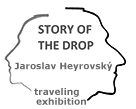The role of gangliosides in the development of neurodegenerative amyloidogenic diseases: Molecular insights by advanced fluorescence microscopy
Ab peptide oligomers are neurotoxic and thought to be implicated in Alzheimer's disease (AD). Formation of Ab oligomers in the brain may be mediated by neuronal membranes. Although the metabolism of the lipid class "ganglioside" is linked to AD their role in oligomerization is controversial. Recently, using the sensitivity of single molecule fluorescence and taking advantage of model membrane systems containing essential lipids with well-defined compositions, we showed that physiological levels of ganglioside GM1 prevent in-membrane oligomerization of Ab. Based on our findings we propose to answer several questions: Do other gangliosides inhibit oligomerisation, in similarity to GM1? What is the molecular mechanism of GM1's inhibitory power? How large are the oligomers and what does their size depend on? Do other gangliosides self-organise into membrane nanoheterogeneities, in similarity to GM1? Is the inhibitory effect of GM1 on Ab oligomerisation generic to other amyloidogenic proteins? Do oxidised lipids and sterols influence that inhibitory effect of GM1?
AMARO Mariana Ph.D.
 jh-inst.cas.cz
jh-inst.cas.cz














